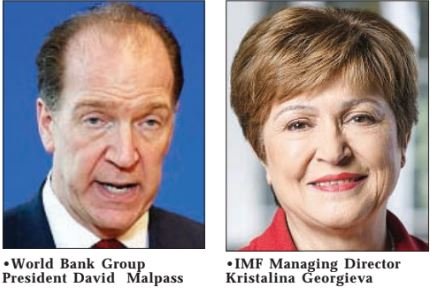
IMF, World Bank Request Rich Nations to Fill $1.6bn Concessional Lending Gap
International Monetary Fund (IMF) and World Bank have appealed to wealthier countries to help plug a $1.6 billion gap in a concessional loan disbursed to low-income countries during the rampaging COVID-19 pandemic.
The call was amplified at the ongoing 2023 IMF-World Bank annual Spring Meetings in Washington DC.
The International Monetary Fund also called on all countries, especially those in the low-income category, to closely align their fiscal and monetary policies to combat inflation and build buffers to absorb unforeseen circumstances.
The global lender explained that countries without sufficient fiscal buffers will be insulated from longer and deeper recessions when confronted by uncertainties.
Public debt is higher and growing faster than projected before the COVID-19 pandemic, driven mainly by the United States and China, the world’s two largest economies.
About 66 per cent of countries are projected to see their public debt to Gross Domestic Product (GDP) ratios decline through 2028 after COVID-related surges.
But a significant number of large economies, including Brazil, China and the United States, are seeing rapid growth in their debt-to-GDP ratios.
Speaking during a chat with journalists, the IMF Director of Fiscal Affairs Department, Vitor Gaspar, said global public debt soared to almost 100 per cent of GDP in 2020 before posting its steepest drop in 70 years by 2022.
However, he added that the global public debt remained at about eight percentage points above the pre-pandemic level.
Rather than normalising, he said the ratio was expected to start rising again this year, hitting 99.6 per cent of GDP in 2028, which is the last year of the IMF’s forecast horizon. He warned that risks were high, noting that reducing debt vulnerabilities should be an “overriding priority,” especially in low-income developing countries where 39 countries were already in or near debt distress.
The IMF Director stated further that recent banking problems in the United States and Switzerland had heightened risks of an expanding financial crisis, which would put even more pressure on public sector balance sheets if governments were called in to help.
To guard against further and worsening problems, he said regulators should consider strengthening crisis management frameworks and their regimes for dealing with troubled institutions.
Gaspar said; “During the pandemic, many countries suspended fiscal rules, activated escape clauses, or modified fiscal targets to allow for the extraordinary policy response. Now, most plan to revisit their fiscal rules and frameworks before re-enacting them.
“For the world, public debt-to-GDP ratios fell sharply in 2021 and 2022, bringing them about halfway back from the increase of about 15 percentage points of GDP in 2020. However, going forward, debt ratios are projected to start going up again in 2023 and continue to increase by about 1¼ percentage points per year over the medium term through 2028.
“Taken together, the level of public debt is now more elevated and projected to grow faster than foreseen before the pandemic, at the same time that real interest rates are also rising.”
He recommended that fiscal policy should support monetary policy in bringing inflation back to target in a timely manner, noting that stronger fiscal balances can contribute to cooling off aggregate demand and, hence, moderate the required increase in policy rates.
“In addition, rebalancing public finances helps limit public finance risks, and a more balanced policy mix contributes to financial stability, reducing the risk of observing fiscal-financial feedback loops,” he added.
This year’s spring meeting will be held amid high inflation and ongoing concerns about the health of the banking sector following the dramatic collapse of Silicon Valley Bank.
